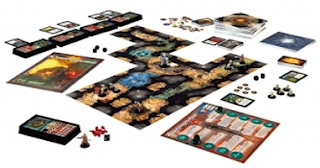 One player controls the Redeemer (essentially a Paladin or Cleric) and his condemned warriors, a group of thugs and and murderers with nothing to live for but their redemption. The other player controls the demon and his troglodytes. It amounts to 17 beautifully pre-painted plastic minis. One may think this is a limited selection in the grand scheme of things, but read on.
One player controls the Redeemer (essentially a Paladin or Cleric) and his condemned warriors, a group of thugs and and murderers with nothing to live for but their redemption. The other player controls the demon and his troglodytes. It amounts to 17 beautifully pre-painted plastic minis. One may think this is a limited selection in the grand scheme of things, but read on.The board is modular, a series of square tiles, which get turned over as you explore the catacombs. Many of the boards have special rules, including movement-affecting terrain and game events, such as card drawing or treasure collecting. The tiles are sturdy, the art gorgeous, and the random aspect of the catacombs really increases the re-playability of the game, while adding to the immersion of "where the hell am I" for the Redeemer player.
Speaking of re-playability, there is quite a bit in Claustrophobia to keep you playing. The Redeemer can start the game with a number of different spells and abilities. While the game is scenario-based - there are several in the book and more at the designer's website - the random abilities and the random board seem to provide plenty of fresh play. The condemned are outfitted with different weapons and abilities as well.
While the demon figure doesn't change (duh!), the demon the figure represents does. Basically you have a card that explains the stats and abilities of the demon you're using. There's some nice variance here; I can't wait to try more out.
I mentioned I have "ooh, shiny" syndrome, but if you know me, you know I wasn't necessarily referring to the beauty of the components. The big draw for me was actually the mechanics.
Each good guy character has an interesting take on a character sheet. The character card is dropped into a raised plastic tray, similar to those found in my favorite racing game, Formula D. You use pegs to show damage on these, and there's a spot for a six-sided die. The die you put in that spot determines your stats for the round.
At the beginning of the turn, the Redeemer player rolls a number d6s equal to the number of active characters in play. The dice are then assigned to the character cards, and the numbers correspond to a line of stats. The Redeemer's abilities also tend to correspond to a die number, so you only get them when the right die is used on his card. I mentioned peg holes for damage. These also correspond to lines of stats. If a line is marked by a peg, you can't use that line any longer. If you're forced to put a die in a card that matches a canceled line, that character is out for the round, for the most part.
On the demon side, as I mentioned before, the demon's stats and abilities are determined by which demon you're playing. The troglodytes have their own board. Here dice are rolled to give the troglodytes modified stats or to give the demon player access to more monsters or special events that generally make things hard on the good guys.
Both sides get to make fun - and tough - choices. It makes for an enjoyable tactical experience, as you react to your opponent and deal with the "hand you're dealt" throughout the game.
The rules recommend you begin with a scenario where the Redeemer and his condemned are trying to escape the catacombs, and the demons are pretty much trying to eat the good guys. My friend Robert and I went with this scenario. I played evil (indeed!), and Robert played the Redeemer and his condemned.
At the start of the scenario, it seemed like the good guys were going to run away with it. A d10 was used to show how close the Redeemer was getting to the exit, and it was ticking up fast! Evil eventually got some control and stomped the good guys. Our first play went pretty fast, considering we had the book in hand. I absolutely believe the 45-minute play time on the box.
Combat in the game is simple. Roll a number of d6s equal to the attacker's Combat stat. Each die that beats the defender's Defense causes a wound. Simple and efficient.
Claustrophobia is aptly named. The Redeemer starts out confident; then the game starts to really close in on him. This was exacerbated by the fact that I had two rules wrong, both of which favored my side (not deliberate, I swear!). While we initially thought the game was too skewed toward the bad guys, it turns out it's much more balanced when you play the game correctly!
It's a good sign when the loser of the game wants to play again, and once we determined my rules flub, Robert was ready to play again.
My one complaint about Claustrophobia is the dice. The d6s are OK, but the d10 is very obviously cheap. At the very least, I will be replacing the d10. I may replace the 6s if I can match the size right.
Overall I recommend checking out Claustrophobia. It's a great two-player game - one of my new favorites (despite it being on my shelf two years).




